
Feature Article
COVID-19 and Food Safety
Recently, several local warehouse workers responsible for labelling prepackaged foods were confirmed to be infected with Coronavirus Disease 2019 (COVID-19). This arouses public concern as to whether touching objects (including food packaging) contaminated with the novel coronavirus would contract the disease. The virus is mainly transmitted through respiratory droplets, but it can also be transmitted through contact. In this issue, we will look into the matters related to COVID-19 in the food business and highlight the key hygienic measures.
Can COVID-19 Be Transmitted by Food Packaging?
Recent research suggested that the novel coronavirus can survive on the surfaces of objects for a few hours to several days under controlled, experimental conditions. However, the virus cannot multiply in food or food packaging. The risk of acquiring the virus through food packaging appears to be very low in real-life situations. According to the World Health Organization (WHO), it is highly unlikely that people can contract COVID-19 from food or food packaging. To date, there is also no evidence of viruses that cause respiratory illnesses being transmitted via food or food packaging. Among the 1 000-odd cases of COVID-19 reported so far in Hong Kong, none was identified as potentially transmitted through food packaging.
Should Consumers Sanitise Food Packaging?
Contaminated hands play a significant role in facilitating indirect contact transmission by transferring infectious viruses from one surface to another and even into one’s body. Compared with food packaging, high-touch points such as door handles, handles of shopping trolleys and water taps pose a greater risk of infection. The more frequently they are touched by different people, the higher the risk of contamination. While some people may still opt to disinfect food packaging surfaces with common household disinfectants like alcohol-based wipes or sprays if needed, it is more important to wash hands thoroughly, especially before touching eyes, nose and mouth, after returning home from grocery shopping and after handling and storing purchased food products.
What Can the Food Business Do To Fight COVID-19 Together?
As the food business provides for the daily needs of the public, trade members should take appropriate hygienic measures to protect the health of their employees and customers. It is crucial that staff with fever or respiratory symptoms should stop going to work or travelling to crowded places, and should wear a surgical mask and seek medical advice promptly. Staff should also put on surgical masks and have their body temperatures regularly checked when working face to face with the public or in a crowded area. Other anti-epidemic measures include disseminating health advice to employees, providing hand-washing facilities and ensuring a clean and hygienic work environment. Surfaces, especially high-touch points in the food premises, should be cleaned and disinfected frequently. Food handlers should often wash their hands. If they develop symptoms of COVID-19, such as fever, cough and shortness of breath, they should refrain from work and seek medical consultation. Social distancing (i.e. keeping a distance of at least one metre from other people) in the food business environment should be maintained as far as possible to reduce the risk of disease transmission. Where adequate social distancing cannot be arranged due to space constraints, other separation measures should be considered. (See Figure 1)
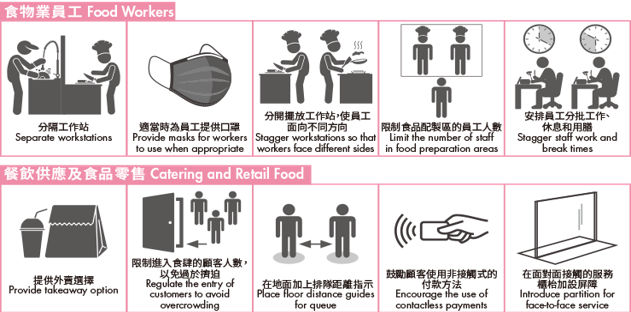
Figure 1: Social distancing measures for the food business
Moreover, food business operators should continue to uphold food safety practices (e.g. the Five Keys to Food Safety and the Hazard Analysis and Critical Control Point (HACCP) System) to prevent foodborne illnesses.
In addition to the health advice issued by the Centre for Health Protection, the trade can also make reference to the recommendations on enhancing hygiene as illustrated in Figure 2 to prevent the spread of COVID-19.
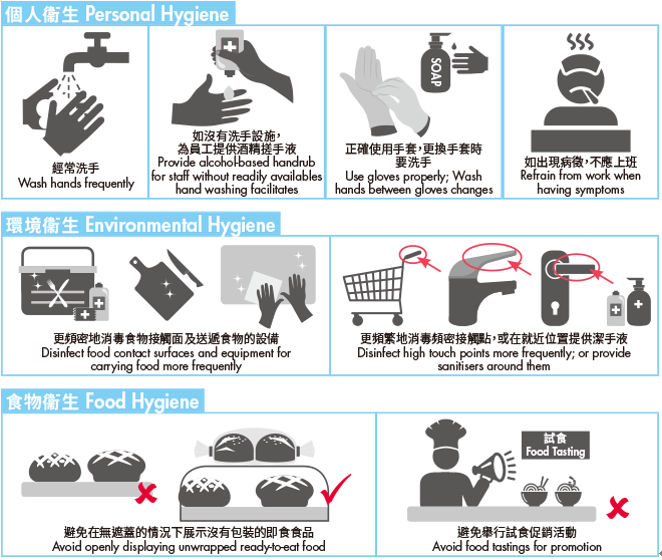
Figure 2: Suggested hygiene improvement measures for the food trade
Eat Safe: Home-packed Meals, Takeaways and Delivered Foods
During the COVID-19 pandemic, many people prefer packing their own meals or ordering takeaways and delivered foods from restaurants. Regardless of where foods are prepared, it is important to handle foods properly to maintain food safety. The following paragraphs will discuss the major food safety risks of packed meals prepared by restaurants and give recommendations on how to reduce the risk of foodborne diseases.
Food Safety Risks of Packed Meals Prepared by Restaurants
Takeaways and delivered foods are usually not consumed instantly after preparation. They will be either stored or transported for some time before being served, during which foods may be contaminated. If these foods are not kept properly, pathogenic bacteria present in the foods may grow to an unsafe level or produce heat-stable toxins, subsequently leading to illnesses.
Once foods are picked up by consumers or delivery persons, they should be conveyed as soon as possible if temperature control is not in place. As a rule of thumb, in the absence of temperature control, prepared foods left at room temperature for not more than two hours can be refrigerated for later use. Otherwise, they should be consumed within four hours. Foods left at room temperature for more than four hours must be discarded.
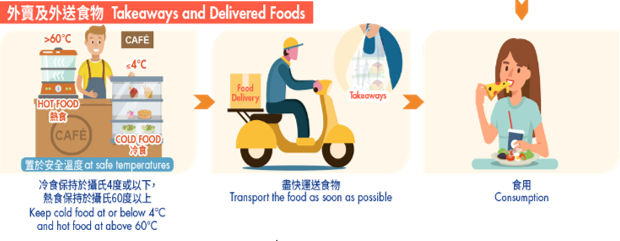
Figure 3: Procedures for handling takeaways and delivered foods
Key Points to Note
- Takeaways and delivered foods are not intended for immediate consumption after preparation. If these foods are not handled properly, the risk of foodborne diseases will increase.
- If cooked food is to be cooled for later consumption, cool it rapidly and maintain a cold temperature during storage. The food should be thoroughly reheated before consumption.
- Keep food out of the temperature danger zone (i.e. 4°C to 60°C) to limit the growth of microorganisms. Apply the 2-hour/4-hour rule if no temperature control is in place.
Advice to the Trade
- Avoid preparing food too far in advance of service. Keep hot food hot (above 60°C) and cold food cold (at or below 4°C).
- Shorten the time of keeping delivered food without temperature control. Remind customers to consume the food as soon as possible where appropriate.
- Adopt the Five Keys to Food Safety and implement the HACCP system or follow its principles to ensure food safety. Keep records properly and adhere to the time and temperature requirements for food storage.
Readers' Corner
Home Cooking in the Time of Pandemic
The Government has called on the public to practise social distancing to limit the spread of COVID-19. In fact, people are more used to cooking at home than dining out these days. This article highlights the points to note in home cooking from the perspective of food hygiene. We should pay attention to these points to ensure food safety, especially in the time of pandemic.
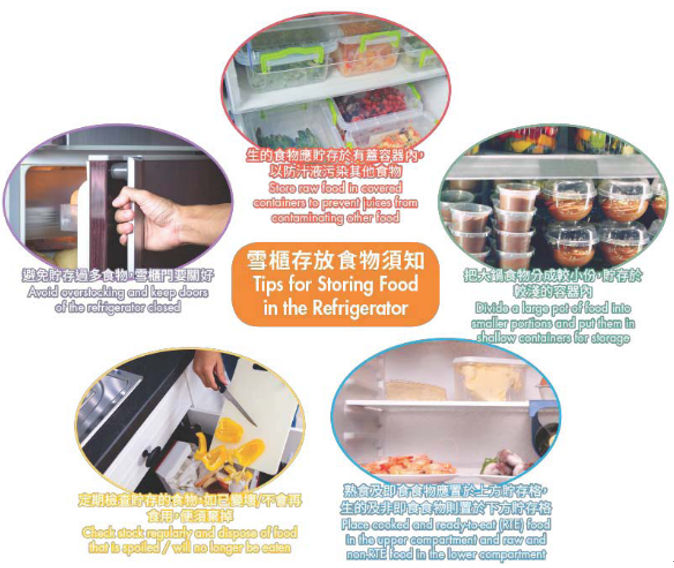
Figure 4: Tips for storing food in the refrigerator
Plan Ahead When Stocking up on Food
Some consumers may buy more food to meet the need for days. However, food can be spoiled and wasted if not kept properly. It is often wise to estimate and buy the quantity that is really needed to avoid overstocking. We can maintain a list of favourite dishes (and their ingredients) of household members and store the food items properly after purchase, such as placing them in the refrigerator (at 4°C or below) or freezer (at -18°C or below). The proper ways of storing food in the refrigerator are shown in Figure 3. For food not requiring refrigeration, storage in a cool and dry place can help reduce bacterial growth.
Follow Safe Food Handling Practices
Although the novel coronavirus is unlikely to be transmitted to humans via food, the general rules of hygiene for preparing food should be observed. Wash hands before handling food or when they are contaminated by respiratory secretions (e.g. after coughing or sneezing). Clean hands with liquid soap and water if they are visibly dirty or soiled with body fluids. Other food safety measures such as handling raw and cooked food separately and cooking food thoroughly should also be maintained.
Proper Handling of Leftovers
There will be leftovers when people cook more than they can eat. For the sake of convenience, some families may also prepare a large amount of food in one sitting for later consumption. However, unfinished food is susceptible to spoilage and contamination if not cooled and stored properly.
To prevent bacterial growth, food should be cooled rapidly to a temperature suitable for refrigeration. Food can be cooled down quickly by slicing larger pieces into smaller ones. Leftovers should be covered, wrapped in airtight packaging or sealed in storage containers. These practices help keep bacteria out, avoid cross-contamination, retain moisture in food and prevent leftovers from picking up odours from other food items in the refrigerator. Most importantly, food should be refrigerated within two hours after preparation and discarded if left at room temperature for more than four hours.
One More Step Forward - Reduce Dietary Intake of Sodium and Sugar
With more time spent at home, it is a good opportunity for us to build healthier eating habits by cooking our own meals. Noting that too much sodium and sugar in food can increase the risk of chronic diseases, we can control the amount of salt and sugar added to our dishes through home cooking. By reading the nutrition labels on prepackaged foods, we can also find out the amount of sodium and sugar we would absorb through consumption of the products.
Food safety is a prerequisite for a healthy diet. In the time of pandemic, it is of utmost importance to ensure food safety. Taking a renewed interest in home cooking, the public should always observe the "Five Keys to Food Safety" to prevent foodborne diseases.
Spot Check
Food Premises in Close-up
1. Sandwiches
Between 21 and 28 May 2020, the Centre for Health Protection received reports of 96 clusters of food poisoning outbreaks from consumption of sandwiches, all of which were attributable to an unlicensed food factory and 229 persons were affected. Laboratory tests found 12 stool specimens and one food remnant sample positive for Group D Salmonella.
Follow-up actions were taken by the Centre for Food Safety (CFS) and the Environmental Hygiene Branch of the Food and Environmental Hygiene Department (FEHD), which include deploying staff to the food factory and retail outlets of the sandwiches in question for investigation, as well as tracing their distribution. As advised by the CFS, all the retail outlets have suspended the sale of the sandwiches. Two samples were taken from one of the retail outlets for Group D Salmonella tests. The investigation found that cross-contamination between raw and cooked food might have occurred when the sandwiches were being prepared in the food factory, and that temperature control was improper when the prepared sandwiches were delivered to and stored at the retail outlets. Prosecution has been instituted against its person-in-charge for operating an unlicensed food factory. In parallel, the CFS has provided health education on food safety and hygiene to the staff concerned and requested them to carry out thorough cleaning and disinfection of the premises.
Sandwich is a high-risk food as its preparation involves manual handling of ingredients directly, which is prone to cross-contamination. Worse still, uncooked ingredients (e.g. raw vegetables or raw eggs) or cold items (e.g. ham) may be added to sandwiches which may hardly be heated before consumption. If the sandwiches are improperly stored, e.g. at the temperature danger zone (4-60ºC) for a long time, pathogenic bacteria may significantly multiply and cause food poisoning.
Advice to the Trade
- It is an offence for a person to prepare food for sale without a valid food business licence issued by the FEHD.
- The food labelling requirements (including a valid expiry date marking) for the sale, advertisement and display of prepackaged sandwiches under the Food and Drugs (Composition and Labelling) Regulations (Cap. 132W) should be observed.
- Sandwiches should be stored at 4ºC or below and strict time/temperature control should be in place throughout the supply chain.
- In preparing sandwiches, food handlers should always wash their hands, especially after touching raw food and right before handling cooked/ready-to-eat food. Hand washing and drying facilities should be suitably located in food preparation or production areas to ensure they are readily accessible to food handlers. Where possible, non-hand operable taps and single-use towels should be equipped to help prevent recontamination of clean hands.
- Raw food should not be placed at the handling area for cooked/ready-to-eat food.
- Storage of raw food and cooked/ready-to-eat food in close proximity inside the fridge should be avoided. Raw food should be placed below cooked/ready-to-eat food in the fridge to prevent juices from dripping onto cooked/ready-to-eat food. Two refrigerators had better be installed for separate storage of raw food and cooked/ready-to-eat food.
- Utensils and worktops should be washed with hot water and detergent after each use, especially after preparing raw food.
- Separate utensils should be used to handle raw food and cooked/ready-to-eat food.
- If a sandwich contains raw vegetables or raw eggs, this should be made known to customers (e.g. pregnant women, young children, the elderly and immunocompromised persons) so that they can make an informed choice.
2. New Arrangement for Importing Brazilian Meat, Poultry and Eggs
In response to the incidents of meat quality and falsified health certificates for meat products from Brazil in March and September 2017 respectively, the CFS has been working with the Brazilian authority to improve the efficiency of food tracing in food incidents, enhance the safeguard of food safety and further refine the import regulation of Brazilian meat.
The CFS and the Brazilian authority have worked out specific import requirements based on food safety considerations and made new arrangement for the import of meat, poultry and eggs from Brazil.
The new arrangement has been in effect since 18 May 2020. Under the new arrangement, the Brazilian authority will only issue official health certificates to food processing plants and premises which it considers eligible for exporting meat, poultry and eggs to Hong Kong. These eligible establishments are listed on the website of the Brazilian authority. In addition, the official health certificates for meat, poultry and eggs have been revised and samples of which can be viewed on the website of the CFS via the following link:
https://www.cfs.gov.hk/english/committee/Notes_and_Presentation_Materials_TCF_20191120.html
The CFS recommends the trade to ascertain whether certain establishments are on the eligible list posted on the website of the Brazilian authority before engaging in trading of meat, poultry and eggs with them.
Updates on CFS
Food Safety Day 2020
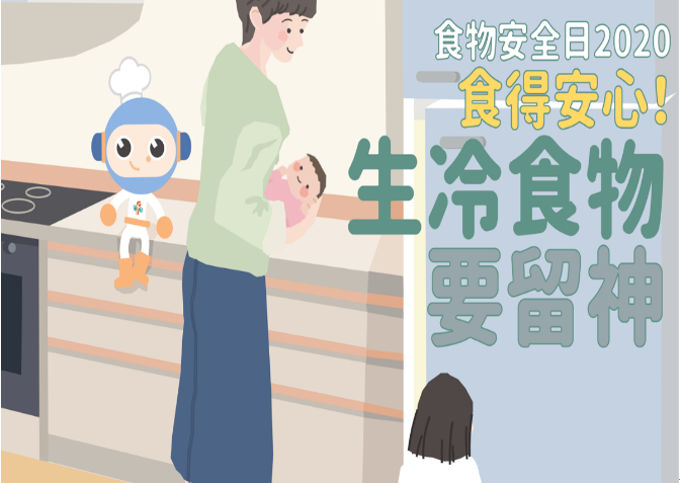
The Food Safety Day is an annual signature event of the CFS with a view to strengthening collaboration among the Government, the trade and the public. The theme for this year is "Eat Safe! Know Your High-risk Foods".
When "raw and cold food" is mentioned, it is usually sushi, sashimi or raw oysters that come to people's minds. Actually, this is a loose description of raw or undercooked foods, generally referred to as high-risk foods. You may not notice that some common food products may contain raw or undercooked ingredients, for examples, there are mango pudding made with raw eggs, smoked salmon (a raw food) sandwiches and congee prepared with undercooked beef. Through Food Safety Day 2020, the CFS will advise the public (especially the susceptible populations) to adopt a vigilant approach in handling and consuming high-risk foods in their daily diet. The CFS will also remind the trade what efforts can be made to enable consumers to make informed choices when purchasing high-risk foods.
Please stay tuned to the CFS website for updates on Food Safety Day 2020.
Briefing of Activities
Trade Consultation Forum
The CFS conducts the Trade Consultation Forum regularly for representatives from various food trade associations, food manufacturers, food importers, wholesalers and retailers to exchange views on food safety matters, discuss food safety control measures and provide feedback on risk communication activities.
The 72nd meeting of the Forum was held on 29 November 2019, during which the CFS representatives briefed the trade on the new arrangements for import of Brazilian meat, poultry and eggs into Hong Kong and the guidelines for providing consumer advice on high-risk foods on menus. There were also discussions on food safety concerns arising from the recent social events and an introduction to the Food Trader Portal and the registration scheme for food traders.
Members of the trade enthusiastically expressed their views on various issues at the forum. The CFS would like to thank all the attendees for their active participation.
Details of the forum have been uploaded to the CFS website (http://www.cfs.gov.hk/english/committee/committee_tcf.html). Please browse the webpage for details.
Upcoming Activities
Centre for Food Safety Trade Talk and Workshop on HACCP
The CFS is organising the Trade Talk and Workshop on HACCP from April to December this year to promote proper food handling practices among employees. The aim of the activity is to encourage food practitioners to adopt the HACCP System and draw up a food safety plan in food processing to enhance food safety through active participation and collaboration between the Government and the trade.
The activity will facilitate participants to gain understanding of the principles and operation of the HACCP System and the “Five Keys to Food Safety” (Choose, Clean, Separate, Cook and Safe Temperature) advocated by the WHO for effective prevention of foodborne diseases. The CFS has made consistent efforts to promote healthy eating habits. It will take this opportunity to raise public awareness of a dietary culture with less salt and sugar, and to introduce nutrition labelling and the adverse effects of trans fats on health.
Please visit the CFS website (http://www.cfs.gov.hk) for the latest updates on the Trade Talk and Workshop on HACCP.
Food Safety Q&A
Can COVID-19 Be Transmitted via Food?
Karly: Daddy, today at lunch break, Fanny, who sits next to me, was scared by Siu Yin. When she was eating, he told her COVID-19 can be transmitted by food. Fanny was so frightened that she did not eat anymore. Can COVID-19 be spread by food?
Daddy: Based on the present scientific findings, there is no evidence that humans can catch COVID-19 via food. The WHO and food safety assessment authorities around the world do not consider that people are likely to be infected by the novel coronavirus via food. However, the WHO advises that we should always observe personal, food and environmental hygiene to ensure food safety.
Karly: I get it now. Daddy, your explanation is so clear. I will let Fanny know tomorrow.
Daddy: Remember to remind your classmates to pay attention to food safety and wash their hands thoroughly before having meals. Actually I get the related information from a website. You can view it by clicking this link: https://www.cfs.gov.hk/english/whatsnew/files/Food_Safety_Advice_on_Prevention_of_COVID-19_and_FAQs_rev_20200228.pdf.
Karly: I see.
Truth Against Fallacy
Food Additives in Perspective
With the advent of the food processing technology, food additives are playing an important role in ensuring food safety and food quality. Most food products on supermarket shelves, in particular prepackaged foods, contain food additives. For instance, antioxidants can be found in vegetable oils to prevent them from turning rancid, and preservatives are added to bread to prevent mould and bacterial growth that would otherwise cause decay before the expiry date. In some breakfast cereals, sweeteners are used as a substitute for sugar to lower calories. Not only do food additives enhance the taste, texture and other qualities of food, they also improve the safety and extend the shelf life of food products so as to prevent foodborne diseases. Despite long-time and widespread application of food additives, there are concerns about their safety from time to time.
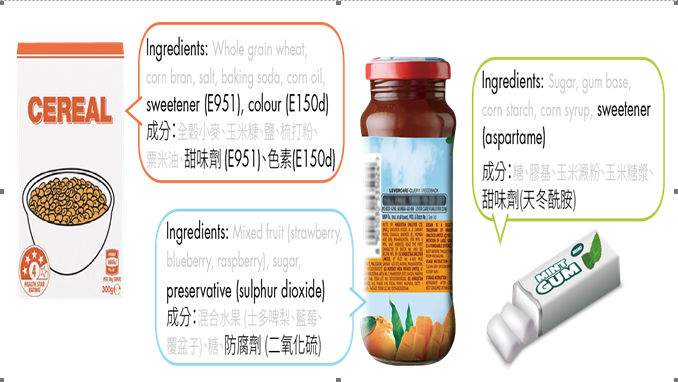
What Are Food Additives?
Food additives are substances, either natural or synthetic, added to food to help maintain or improve its safety, freshness, taste, texture, appearance, etc. Based on their technological functions, food additives are classified into different functional classes such as antioxidants, preservatives, colourants, sweeteners, acidity regulators, flavour enhancers, thickeners, emulsifiers, etc.
Are Food Additives Safe for Consumption?
Before a food additive is ascertained as safe for food use, it has to go through rigorous safety assessment. National and international food safety authorities, such as the Joint FAO / WHO Expert Committee on Food Additives (JECFA), collect and evaluate scientific data to assess the safety of food additives. If a food additive may not be safe for food use, it would not be approved for food application. Moreover, the JECFA will reassess an approved food additive based on new scientific data as and when necessary to ensure that it is safe for use.
Just as some people are allergic to certain foods (e.g. crustaceans and peanuts), individual persons may have allergic or adverse reactions to certain food additives. For example, people allergic to sulphur dioxide (a food additive) may experience breathing difficulties, headaches and nausea after consuming food containing this chemical compound.
How Are Food Additives Regulated in Hong Kong?
In Hong Kong, there are regulations which spell out the standards for specific food additives (e.g. antioxidants, preservatives, colourants and sweeteners) allowed in food. For food additives with no specified standards stipulated in the regulations, food traders should ensure that they are used in accordance with the principles of the Good Manufacturing Practice, that is, only the minimum amount of food additives should be applied to achieve the desired technological effect, and the food must be fit for human consumption. The CFS will conduct risk assessment on food additive levels of food samples if necessary.
How to Make an Informed Choice?
According to the Food and Drugs (Composition and Labelling) Regulations (Cap. 132W), if a food additive is used in a prepackaged food available for sale in Hong Kong, it must be listed by its functional class together with its specific name or identification number in the ingredient list on the food label. For example, if aspartame is added to a prepackaged food as a sweetener, it must be listed as sweetener (aspartame), sweetener (E951), or sweetener (951).
Advice to the Trade
- The Good Manufacturing Practice should be followed in food preparation to avoid excessive use of food additives.
- Exercise due care in choosing food additives. Choose the appropriate type(s) of food additive(s) and apply only the minimum amount to achieve the desired technological function.
- The trade should take note of the regulatory requirements under the Public Health and Municipal Services Ordinance (Cap. 132) regarding the use and labelling of food additives.
- Seek the advice of food scientists or the relevant authorities if there is any doubt on the use and labelling of food additives.
- The trade may also refer to the website of the JECFA (https://www.who.int/foodsafety/areas_work/chemical-risks/jecfa/en/) for the safety evaluation results and specifications of food additives.
Brain Gym
Multiple Choice Questions
- Which day in 2019 was designated by the United Nations as the World Food Safety Day?
- 1 July
- 6 October
- 7 June
- Which of the following practices will not lead to cross-contamination of food?
- Let juices from raw shellfish in the fridge drip onto the cake below.
- Process cooked siu-mei right after handling raw food.
- Put well covered cooked food on the upper compartment of the fridge.
- Which of the following is not a correct statement about food additives with no relevant standards specified in the laws of Hong Kong?
- Follow the Good Manufacturing Practice to apply only the minimum amount of food additives to achieve the desired technological effect.
- These food additives are exempted from inclusion in the ingredient list on the food label.
- Make reference to the safety evaluation results of the Joint FAO/WHO Expert Committee on Food Additives in applying these food additives.
Answers:
1. c 2. c 3. b
Enquiries and Subscription
Printed copies of the Food Safety Bulletin can be obtained from the Communication Resource Unit at Room 401, 4/F, Food and Environmental Hygiene Department Nam Cheong Offices and Vehicle Depot, 87 Yen Chow Street West, Sham Shui Po, Kowloon. For enquiries, please call 2381 6096.